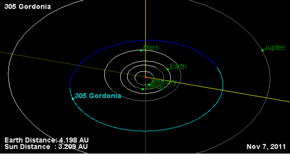305 Gordonia
 Orbit diagram of 305 Gordonia | |
| Discovery | |
|---|---|
| Discovered by | Auguste Charlois |
| Discovery date | 16 February 1891 |
| Designations | |
| (305) Gordonia | |
| Pronunciation | /ɡɔːrˈdoʊniə/ |
| A891 DA; 1938 SC1 1970 SP1 | |
| Main belt | |
| Orbital characteristics[1] | |
| Epoch 31 July 2016 (JD 2457600.5) | |
| Uncertainty parameter 0 | |
| Observation arc | 123.90 yr (45255 d) |
| Aphelion | 3.69187 AU (552.296 Gm) |
| Perihelion | 2.49627 AU (373.437 Gm) |
| 3.09407 AU (462.866 Gm) | |
| Eccentricity | 0.19321 |
| 5.44 yr (1987.9 d) | |
| 43.0648° | |
| 0° 10m 51.946s / day | |
| Inclination | 4.44401° |
| 207.494° | |
| 261.346° | |
| Physical characteristics | |
| Dimensions | 49.17±1.5 km |
| 12.893 h (0.5372 d)[1] 12.89 ± 0.01 hours[2] | |
| 0.2269±0.014 | |
| 8.77 | |
Gordonia (minor planet designation: 305 Gordonia) is a fairly typical, although sizeable Main belt asteroid.[3]
It was discovered by Auguste Charlois on 16 February 1891 in Nice and named after James Gordon Bennett Jr., his patron.
The light curve of 305 Gordonia shows a periodicity of 12.89 ± 0.01 hours, during which time the brightness of the object varies by 0.17 ± 0.03 in magnitude.[2]
References[edit]
- ^ a b "305 Gordonia". JPL Small-Body Database. NASA/Jet Propulsion Laboratory. Retrieved 11 May 2016.
- ^ a b Menke, John; et al. (October 2008), "Asteroid Lightcurve Analysis at Menke Observatory", The Minor Planet Bulletin, 35 (4): 155–160, Bibcode:2008MPBu...35..155M
- ^ Dynamics of comets and asteroids and their role in earth history. Shin Yabushita, J. Henrard. p.243
External links[edit]
- 305 Gordonia at AstDyS-2, Asteroids—Dynamic Site
- 305 Gordonia at the JPL Small-Body Database
